|
|
|
Sort Order |
|
|
|
Items / Page
|
|
|
|
|
|
|
| Srl | Item |
| 1 |
ID:
147707
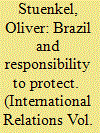

|
|
|
|
|
| Summary/Abstract |
This article questions the still broadly accepted notion that the global debate about Responsibility to Protect (R2P) is divided into a Western (or Northern) ‘pro-R2P’ camp and a non-Western (or Southern) ‘anti-R2P camp’. In the same way, the relatively broadly accepted assertion that R2P is a Western concept overlooks the important contributions developing countries have made in the creation of the norm. Brazil’s stance vis-à-vis R2P, analyzed in this article, is a powerful example of this reality, and the country has, in the past years, temporarily assumed leadership in the discussion about how to strengthen the norm. Paradoxically, Brazil’s move was widely seen as obstructionist. This points to a broader bias that tends observers not to grant non-Western powers the same agency in the creation of rules and norms. The ongoing multipolarization will force observers to correct this vision, as countries in the Global South such as China will be increasingly able to ‘act upon’ R2P, a capacity that so far has been reserved for established powers.
|
|
|
|
|
|
|
|
|
|
|
|
|
|
|
|
| 2 |
ID:
147702
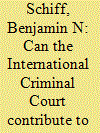

|
|
|
|
|
| Summary/Abstract |
The Responsibility to Protect (R2P) norm asserts that states have duties beyond their borders to help avoid, respond to, and prevent recurrence of circumstances that produce massive human rights violations. Actions undertaken to implement those duties can include aid, reform, or more muscular involvements. The need for such engagement implies that the target state’s government is losing or has lost its legitimacy. Labeling by the International Criminal Court (ICC) of a conflict as a ‘situation’ under its purview asserts that large-scale crimes are likely taking place for which individuals should be held accountable. This should trigger R2P considerations. However, the fit between R2P and the ICC is uncomfortable. Although the ICC may appear a useful tool for R2P, forays into the politics of R2P by the ICC are undertaken at its peril. Moreover, so far, the ICC has not clearly had positive effects upon conflict. While the ICC can be idealized as a contributor to R2P, coordination is formally non-existent and the Court’s protection effects are ambiguous.
|
|
|
|
|
|
|
|
|
|
|
|
|
|
|
|
| 3 |
ID:
147700
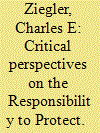

|
|
|
|
|
| Summary/Abstract |
The articles in this Special Issue derive from a conference on the Responsibility to Protect (R2P) held under the auspices of the Center for American and Global Security at Indiana University–Bloomington, 15–16 May 2015. The studies in this issue variously explore the development of the R2P in the United Nations, assess the role of the International Criminal Court in bringing perpetrators of mass atrocities to justice, introduce a territorial dimension to R2P, and elucidate the current position of non-Western emerging countries, specifically the BRICS, on R2P. The most ardent advocates of the doctrine tend to be from the major English-speaking liberal democracies, although prominent African statesmen were also instrumental in promoting the concept. The Libyan experience prompted a reassessment of R2P, magnifying suspicions that the norm may be simply a Western strategy for enhancing influence and effecting regime change. The idea of state sovereignty as responsibility domestically, and the possibility of international assistance to regimes struggling to protect vulnerable populations, has widespread support in the non-Western world. Coercive measures against predatory regimes are not rejected wholesale, but the BRICS are suspicious of Western motives in advocating forcible intervention and justifiably skeptical that such interventions will do more good than harm.
|
|
|
|
|
|
|
|
|
|
|
|
|
|
|
|
| 4 |
ID:
147704
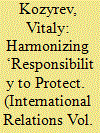

|
|
|
|
|
| Summary/Abstract |
This article examines the recent evolution of China’s policies toward the Responsibility to Protect (R2P) concept in the context of a changing international environment. As an example of an emerging ‘non-Western’ alternative to the existing normative consensus, the Chinese perception of the norm reflects the nature of the ongoing new East–West divide and is derived from Beijing’s new vision of a future world order and China’s role in it. In 2001–2011, China supported R2P as a new mechanism to revise Western practices of humanitarian interventionism and to contribute to a changing multilateral global international legal order exemplifying China’s new status as a responsible ‘global citizen’. When the R2P norm was politicized by the West as part of its global democratic interventionist policies of 2005–2014, China’s predominantly globalist vision of the international rule of law was replaced by its predominantly security-driven approach. This perspective, while recognizing the ongoing globalization of sovereignty, calls for a ‘right balance between justice and interest’ by the international community and denies the traditional Western leadership in the norm-making process. The Communist Party of China (CPC) leaders believe that the future evolution of the R2P concept should meet China’s strategic interests, including its global order-forming and institution-building initiatives. Efforts to operationalize the R2P norm will have to take this factor into account.
|
|
|
|
|
|
|
|
|
|
|
|
|
|
|
|
| 5 |
ID:
147706
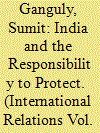

|
|
|
|
|
| Summary/Abstract |
India, though a working democracy, has adopted an ambivalent stance toward the genesis and evolution of the doctrine of the Responsibility to Protect. This article traces India’s views toward the earlier principle of humanitarian intervention, outlines its reactions toward the advent of the norm, and discusses India’s positions on the attempts to apply it to recent international crises. It then argues that India’s cautious support for the principle stems in part from concerns about its potential abuse in the hands of the great powers, post-colonial concerns about the diminution of the norm of state sovereignty, and finally, its own domestic vulnerabilities in the protection of human rights.
|
|
|
|
|
|
|
|
|
|
|
|
|
|
|
|
| 6 |
ID:
147701


|
|
|
|
|
| Summary/Abstract |
This article situates the emergence of the Responsibility to Protect (R2P) concept, later accepted by many as a principle, in the wider flow of events following on the end of the Cold War. Among the hallmarks of change in the United Nations (UN) Security Council as of the early 1990s, in stark contrast to the Council’s preoccupations during its first four decades of activity, was its growing attention to humanitarian considerations relating to conflict, its new willingness to tackle conflicts (mainly internal ones) it might have avoided earlier, and its willingness to experiment with new approaches to resolving them. Just as worries over terrorism and the threat of weapons of mass destruction were to become dominant themes in its work, the humanitarian imperative also incrementally wove itself into the fabric of the Council’s decision-making. It is against this wider backdrop and that of several spectacular UN failures to prevent genocide and other mass humanitarian distress that UN Secretary-General (UNSG) Kofi Annan was impelled as of 1999 to look beyond existing international law and practice for a new normative framework, that while formally respecting the sovereignty of states nevertheless elevated humanitarian concerns and action to the level of an international responsibility to prevent the worst outcomes. Today R2P finds itself competing with other legal and diplomatic principles, but it remains a potent platform for advocacy and, at times, for action by the UN.
|
|
|
|
|
|
|
|
|
|
|
|
|
|
|
|
| 7 |
ID:
147705


|
|
|
|
|
| Summary/Abstract |
Russian leaders consider the Responsibility to Protect (R2P) a Western liberal democratic norm that erodes sovereignty and threatens Russia’s great power status. They suspect the United States and Europe use R2P as a means of effecting regime changes that support their national interests, not as a purely altruistic effort to protect vulnerable populations. Having experienced state collapse, societal fragmentation, and a weakened foreign policy over the past two decades, Russia rejects the Western universalist interpretation of R2P in favor of a civilizational perspective that privileges the Kremlin’s interpretation of when intervention is or is not legitimate. A close analysis of domestic factors in Russian politics, combined with an understanding of Moscow’s newly confident approach to geopolitics, are needed to understand Russia’s position as one of the most vocal critics of the Responsibility to Protect.
|
|
|
|
|
|
|
|
|
|
|
|
|
|
|
|
| 8 |
ID:
147708
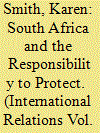

|
|
|
|
|
| Summary/Abstract |
This article provides an overview of the South African government’s evolving position on the Responsibility to Protect (R2P). While the country was an advocate of R2P in the run-up to the 2005 United Nations (UN) World Summit and the related idea of non-indifference in Africa, its conduct while serving as a non-permanent member of the United Nations Security Council (UNSC) and subsequent developments have raised questions about its continued commitment to these principles. In particular, Resolution 1973 (2011) on Libya proved to be a turning point. It is argued that while South Africa continues to support the broad idea of civilian protection, it is in favour of a consultative, regional approach and has become increasingly critical of what it views as the selective application and militarisation of the R2P. In trying to make sense of the apparent contradictions in South Africa’s position, it is necessary to situate the debate against the background of broader tensions in its foreign policy, particularly around the promotion of human rights. These, in turn, are linked to divergent and multiple foreign policy identities that the post-apartheid state is still coming to terms with.
|
|
|
|
|
|
|
|
|
|
|
|
|
|
|
|
| 9 |
ID:
147703


|
|
|
|
|
| Summary/Abstract |
The doctrine of Responsibility to Protect (R2P) faces considerable criticism, of both its inefficacy – its failure to describe an effective pathway around the obstacles to humanitarian intervention in the sclerotic global security system – and its overreach, especially the risk that it enables pretextual agendas of intervention and regime change. Yet neither defenders nor critics have paid much attention to another possibility or risk incumbent in R2P: the likelihood, once intervention is undertaken, that the interveners themselves will be involved in a conflict over territory, whose likely solutions will include, not simply regime change, but partition. The doctrine as we now have it, built thoroughly on a state-centric logic, does not engage with this question, and indeed there are strategic reasons for ignoring the issue: acknowledging such a quality would be too much for R2P’s supporters to admit or its critics to accept. But whatever our normative orientation toward this rising or stumbling doctrine, we ought to be clear about where taking it seriously is really likely to lead us: sooner or later – and more often than we might wish to acknowledge – R2P interventions will force us to confront the logic of partition.
|
|
|
|
|
|
|
|
|
|
|
|
|
|
|
|
|
|
|
|
|